#crustaceas
Explore tagged Tumblr posts
Photo

Poissons - Félix Bracquemond - 1866 - via The British Museum
4K notes
·
View notes
Text

A shield shrimp (Triops australiensis) in Kimberley, Australia
by Ian Bool
#shield shrimp#tadpole shrimp#shrimp#crustaceans#triops australiensis#triops#triopsidae#notostraca#branchiopoda#crustacea#arthropoda#wildlife: australia
1K notes
·
View notes
Photo

1K notes
·
View notes
Text

Strange Symmetries #13: The Hermit Crab Cycle
Hermit crabs are crustaceans that first appeared at the start of the Jurassic, about 201 million years ago. Despite their common name they aren't actually true crabs, instead being a classic example of convergently evolving a crab-like body plan via carcinization.
They also have noticeably asymmetric bodies, with abdomens that coil to one side and differently-sized front claws.

Pagurus bernhardus by Arnstein Rønning | CC BY 3.0
And while modern hermit crabs are famous for inhabiting scavenged snail shells, their fossil record suggests this wasn't always the case.
Originally, they seem to have lived in ammonite shells.
Palaeopagurus vandenengeli lived in what is now northern England during the Early Cretaceous, about 130 million years ago. Around 4-5cm long (~1.6-2"), it was found preserved inside the shell of the ammonite species Simbirskites gottschei.
Its left claw was much larger than its right, and together they would have been used to block the shell opening when it was hiding away inside. And while the exact shape of its abdomen isn't known, it probably asymmetrically coiled to the side to accomodate the spiralling shape of the host shell.
Hermit crabs seem to have switched over to using gastropod shells by the Late Cretaceous, around 90-80 million years ago, possibly due to marine snails developing much stronger sturdier shells during this period in response to the increasing prevalence of specialized shell-crushing predators. The more upright snail shells would also have been much easier to drag around the seafloor than ammonite shells – and meant that they were ultimately less affected by the total disappearance of ammonites during end-Cretaceous mass extinction.
———
NixIllustration.com | Tumblr | Twitter | Patreon
#science illustration#strange symmetries#paleontology#paleoart#palaeoblr#palaeopagurus#paguridae#paguroidea#hermit crab#anomura#decapod#crustacea#arthropod#invertebrate#art#carcinization
1K notes
·
View notes
Note
Hi,
I saw your post about barrel bugs and I wanted to ask if you know more interesting marine parasites?
(Personally I think that dendrogasters are quite cool)
Dendrogasters are pretty cool! I don't know much about them but they look really... odd.
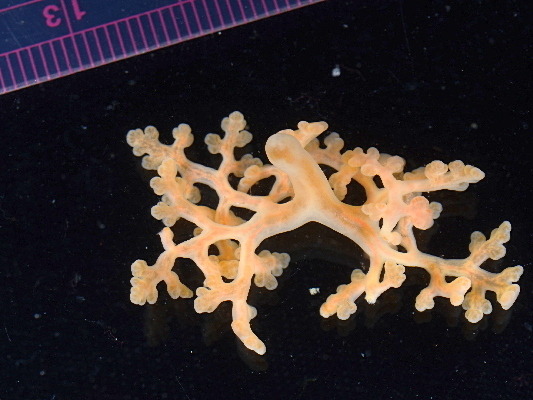
ID: a picture of Dendrogaster showing its unsual body plan, with its branching structures that end in spherical growths. It is light yellow to orange in colour. It is set against a black background and part of a ruler can be seen.
There's a whole host (haha) of interesting marine parasites, and I won't go through all of them now but here's a few that you might like.
Rhizocephala are a parasitic group of barnacles that live on crabs. They have no internal organs except gonads, a few muscles and the remnants of a nervous system. In fact, their only distinguishable bodyy structure is the female reproductive organs, which sit outside of its host's body. Here's a really cool drawing of the filaments which it sends out into its host's body to absorb nutrients directly from their blood:

ID: a black and white drawing of a crab infected with the parasite Rhizocephala. It shows the underside of the crab with the externa (female gonads) visible and a network of filaments that the parasite has grown throughout the host body.
I'm sure you've heard of tongue lice, so I won't labour the point too much, but spark notes is that they attach to the gill arches or tongue of a fish, then cut off the circulation to the tongue so that it withers off. It then replaces the fish's tongue.
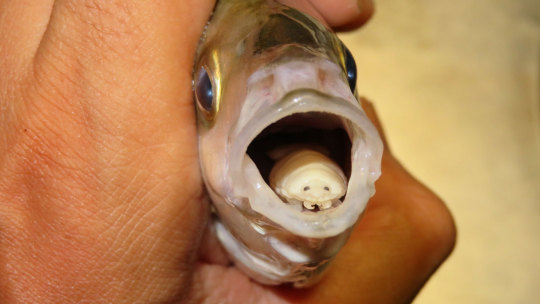
ID: an image of a tongue eating louse inside a fish's mouth. The louse is pale, almost white in colour and has two black eyes. The fish is like :O
Finally, this isn't a marine parasite but you'll see why I include it in a second, but the tongue worms (not to be confused with the tongue eating louse). They are actually terrestrial and mostly infect the respiratory tracts of vertebrates (sometimes, though very rarely, us). What I find interesting is that they have no circulatory, excretory or respiratory organs and rely soley on the host to do all these things. Isn't that cool?

ID: a drawing of a tongue worm (Pentastomida). It has a segmented body that ends in a point. At the other end there are 4 stubby limb-like structures.
If you're still reading , you might be wondering why I picked these ones and why the tongue worm is awkwardly shoved in there? Because @chowaniec I have tricked you; this is not a post about marine parasites, it's a post about the diversity of crustaceans. THAT'S RIGHT, ALL OF THESE ANIMALS, WITH THEIR WEIRD LIFE CYCLES AND UNCRUSTACEANY BODIES ARE COUSINS OF CRABS AND SHRIMP AND LOBSTERS. AND THAT INCLUDES YOUR ORIGINAL SUBMISSION OF DENDROGASTER, WHICH IS WHAT GAVE ME THIS IDEA IN THE FIRST PLACE.
All of these lil guys just have highly specialised bodies that have lost many of the features we associate with crustaceans so that they can be better parasites. It's really only though careful analysis of their lifecycles and genetics that we can even determine them to be crustaceans at all.
I wanted to showcase the immense diversity of crustaceans and the weird and wonderful flexiblity of evolution. I also wanted to show you why morphological criteria for classification fall short, even beyond the "coconuts are mammals" meme.
Thanks for the submission, and thanks for being patient with me! I know this one took a little while longer to receive but I hope it was worth it.
#crustacea are technically not a monophyletic group#it's a really complicated thing but it's also constantly shifting#at any rate these critters don't care#they're just gonna keep evolving to do weird and wonderful things#marine biology#parasites
76 notes
·
View notes
Text


Spec evo terrestrial ostracods.
First one is a small detritivore hiding in mud, leaf litter and rotten wet wood.
Second one is a small predator that hunts other terrestrial ostracods, woodlice and insect larvae.
#speculative paleontology#spec evo#speculative evolution#speculative biology#ostracoda#crustacea#crustacean#not a real crab tbh#funny guys
22 notes
·
View notes
Text
call this pink coralline alga the apple store circa 2009. the way it's got ipods in it
33 notes
·
View notes
Text


Photos 1-2 - Specimen 1
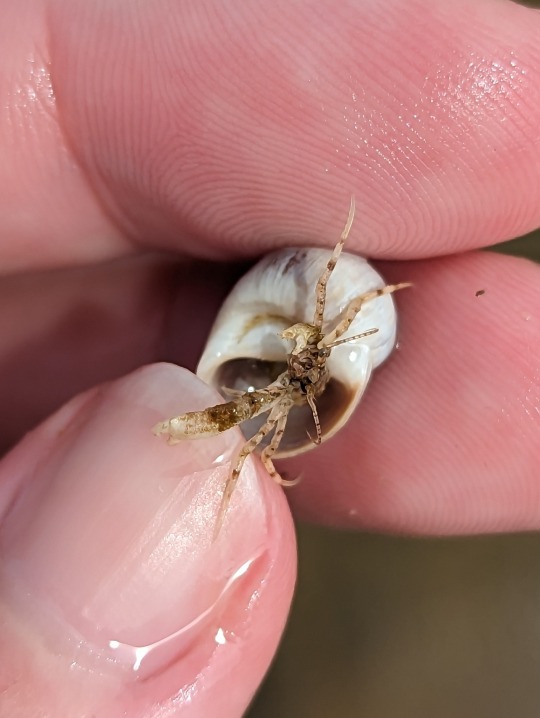

Photos 3-4 - Specimen 2


Photos 5-6 - Specimen 3
D. senex hermit crabs residing in empty Moon Snail shells.
13/08/23 - Diogenes senex
QLD:WET - Flying Fish Point, low tide sandy bay
#invertblr#invertebrates#Arthropods#Arthropoda#Diogenes senex#Paguroidea#Hermit Crabs#Decapoda#Decapods#Crustacea#Crustaceans#hermit crabs#crabs
61 notes
·
View notes
Text
#crustacean#crustaceans#crustacea#arthropods#shrimp#prawns#crab#lobster#crayfish#shrimps#lobsters#crawfish#isopods#barnacle#prawn#arthropod#fish#silly#garlic bread#🍉🦐🍉
21 notes
·
View notes
Text
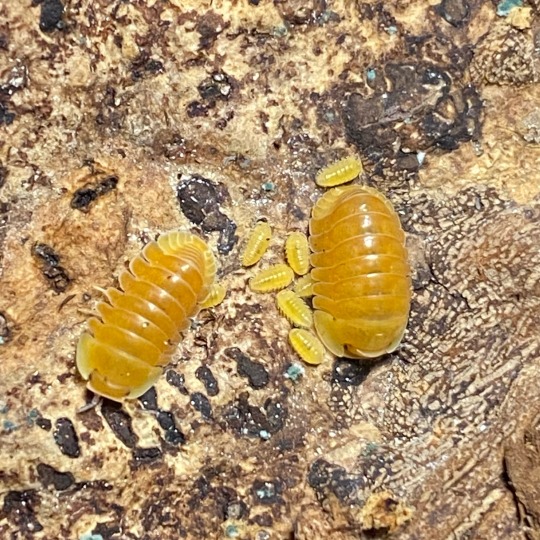

an exciting surprise!! my blonde duckies produced their first offspring!
#upload#isopods#rubber ducky isopod#isopoda#crustacea#animalia#invertebrates#pet isopods#cubaris#cubaris sp
33 notes
·
View notes
Text
ROUND 1D, MATCH 4 OUT OF 8!


Propaganda Under the Cut:
Fairy Crustacea:
Granted, Princess Amy had several fairy godmothers who gave her various gifts, but Crustacea gave her the gift of being Ordinary, which was definitely the most significant!
Katriona:
An adaptation of Sleeping Beauty, Katriona wasn't originally going to be one of the princess' fairy godparents (she was simply a guest there for the naming day, and probably only 16ish at the time, but I am having a difficult time figuring out her age other than she was a young woman), but when the evil fairy showed up gave her cursed gift, she rushed up and babbled her own gift, and was given custody of the princess to protect her. She and her aunt do her best to raise the princess with the hope that "ordinariness" will protect her from the evil fairy's plans.
#fairy crustacea#katriona#the ordinary princess#mm kaye#m.m. kaye#spindle's end#robin mckinley#fairytale#fairy tale#fairy godmother#fairy godparent#poll tournament#poll bracket#polls#character polls#round 1#round 1d#fairy godpoll
3 notes
·
View notes
Photo

Lehrbuch der Zoologie : für höhere Lehranstalten, die Hand des Lehrers und für alle Freunde der Natur - Otto Schmeil - 1930 - via e-rara
1K notes
·
View notes
Photo

A red reef lobster (Enoplometopus occidentalis) off the coast of Kona, Hawaii, USA
by Pierrette Wagner
#red reef lobster#reef lobsters#lobsters#crustaceans#Enoplometopus occidentalis#Enoplometopus#decapoda#Malacostraca#crustacea#arthropoda#wildlife: hawaii#wildlife: usa
438 notes
·
View notes
Text
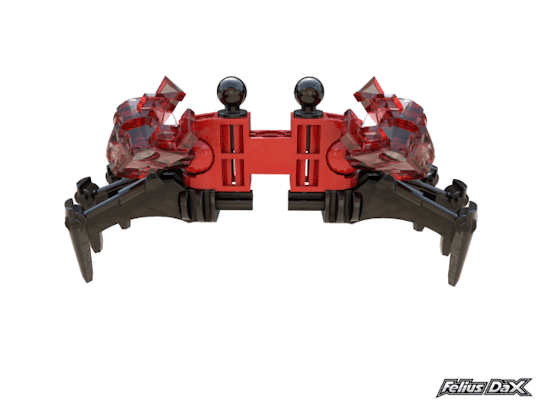
Good Crab 🦀 13 pcs/pzs
170 notes
·
View notes
Text
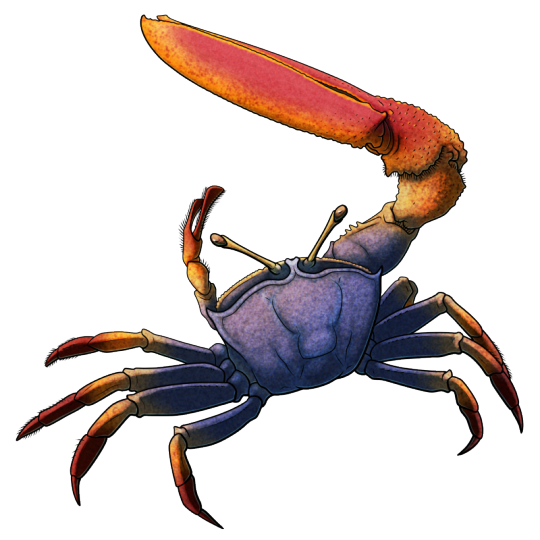
Strange Symmetries #20: The 16 Million Year Fiddler Crab Rave
Many decapod crustaceans have slightly asymmetrical pincers, often with one claw being chunkier and specialized for "crushing" while the other is more slender and used for "cutting".
But fiddler crabs take this sort of asymmetry to the extreme as part of their sexual dimorphism – males have one massively oversized claw, which is used for both visual display to potential mates and for physical fights against rivals.
Some of the earliest fiddler crabs are known from the Miocene of what is now northern Brazil. Although the fossils have been given several different taxonomic names since their discovery in the 1970s (including Uca maracoani antiqua, Uca antiqua, and Uca inaciobritoi) they're currently considered to be indistinguishable from the modern Brazilian fiddler crab, Uca maracoani, meaning that these crabs have remained externally unchanged for the last 16 million years.
Up to about 4cm in carapace width (~1.6"), modern Uca maracoani are found in coastal mangrove swamps and tidal mudflats around the northern and eastern coasts of South America – and some of these environments have also undergone little change since the Miocene. Males of the species can develop their enlarged pincer on either side of their bodies, with lefties and righties seeming to occur in equal numbers.
———
NixIllustration.com | Tumblr | Twitter | Patreon
#science illustration#strange symmetries#paleontology#paleoart#and also not paleoart#palaeoblr#uca maracoani#brazilian fiddler crab#fiddler crab#ocypodidae#brachyura#crab#decapod#crustacea#arthropod#invertebrate#living fossil#art#crab rave
325 notes
·
View notes
Text

Sapphirina spp.
Photo by Solvin Zankl
#sapphirina#sea sapphire#sapphirinidae#copepods#marine#ocean#sea#marine life#marine invertebrates#crustacea#crustaceans#macro photography#animals#nature
24 notes
·
View notes